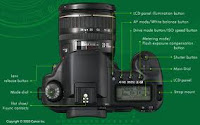Cameras Canon EOS 10D also become a trend among beginners. Either they want to really get the world of photography or just a way of life to mere bandwagon. But for those who are confused to choose a DSLR beginner / entry level DSLR, in this post I will make recommendations Canon EOS 10D camera novice in terms of features.
If you're looking for a first digital SLR, they don't get much more appealing than the 6.3-megapixel Canon EOS 10D. Replacing the popular D60, the 10D provides improved image quality and a slightly more streamlined design without sacrificing the broad accessory and lens compatibility of the EOS line. Though professionals will still sigh longingly for the finer controls and the better performance and image quality of the far more expensive EOS 1Ds, the 10D makes a great choice for those seeking the flexibility and quality of an SLR without the sticker shock.
For the 10D, Canon employs a functional, fairly typical digital SLR (dSLR) design, making only a few departures from this camera's predecessor, the D60. Without a lens but with a CompactFlash card and battery installed, the 10D's solid-feeling black magnesium-alloy body weighs nearly two pounds but fits comfortably into your hand. Most buttons and control dials are clustered on the top right and back left of the camera, while the mode dial sits on the left-hand side of the camera top a sensible choice.
You use a right-hand thumbwheel on the back to navigate the simply organized LCD menu system and change selected settings; you change others via a dial behind the shutter-release button. There are two on/off switches on the back. One controls the main power, and the other turns the thumbwheel off and on; we find the latter relatively useless, as the thumbwheel isn't really susceptible to being turned accidentally.




